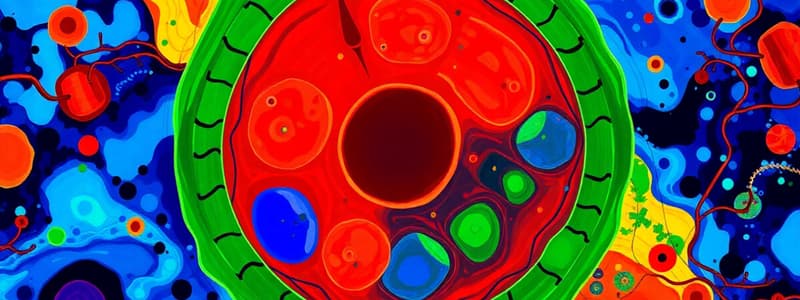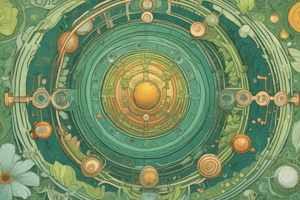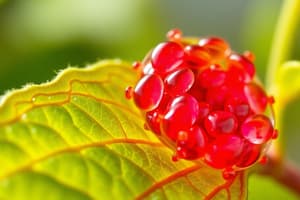Podcast
Questions and Answers
Which of the following structures is found in eukaryotic cells but not in prokaryotic cells?
Which of the following structures is found in eukaryotic cells but not in prokaryotic cells?
Aerobic respiration occurs without the use of oxygen.
Aerobic respiration occurs without the use of oxygen.
False
What is the primary function of ribosomes in a cell?
What is the primary function of ribosomes in a cell?
Protein synthesis
The __________ cycle converts CO2 into glucose during photosynthesis.
The __________ cycle converts CO2 into glucose during photosynthesis.
Signup and view all the answers
Match the following types of transport with their characteristics:
Match the following types of transport with their characteristics:
Signup and view all the answers
What type of mutation results in an addition or deletion of a nucleotide?
What type of mutation results in an addition or deletion of a nucleotide?
Signup and view all the answers
In codominance, only one trait is expressed in the phenotype.
In codominance, only one trait is expressed in the phenotype.
Signup and view all the answers
What is the process by which DNA is transcribed into mRNA called?
What is the process by which DNA is transcribed into mRNA called?
Signup and view all the answers
What is the primary purpose of producers in an ecosystem?
What is the primary purpose of producers in an ecosystem?
Signup and view all the answers
Consumers are organisms that produce their own food using sunlight.
Consumers are organisms that produce their own food using sunlight.
Signup and view all the answers
What is the significance of the 10% rule in trophic levels?
What is the significance of the 10% rule in trophic levels?
Signup and view all the answers
The process of ________ fixes nitrogen in the ecosystem.
The process of ________ fixes nitrogen in the ecosystem.
Signup and view all the answers
Match the following terms to their definitions:
Match the following terms to their definitions:
Signup and view all the answers
Which statement best describes natural selection?
Which statement best describes natural selection?
Signup and view all the answers
Geographic isolation is a mechanism that can lead to speciation.
Geographic isolation is a mechanism that can lead to speciation.
Signup and view all the answers
What is one example of evidence for evolution?
What is one example of evidence for evolution?
Signup and view all the answers
Study Notes
Cell Structure and Function
- Prokaryotic cells lack a nucleus and membrane-bound organelles, while eukaryotic cells have them.
- Cellular organelles have specific functions: nucleus (genetic material), mitochondria (ATP production), ribosomes (protein synthesis), ER (protein and lipid synthesis), Golgi apparatus (protein modification).
Cell Membrane and Transport
- Cell membranes are phospholipid bilayers with embedded proteins.
- Passive transport includes diffusion, osmosis, and facilitated diffusion.
- Active transport requires ATP and includes endocytosis and exocytosis.
Cellular Respiration
- Glycolysis breaks down glucose into pyruvate.
- The Krebs cycle produces electron carriers and ATP.
- The electron transport chain uses oxygen to produce ATP.
- Aerobic respiration uses oxygen; anaerobic respiration (fermentation) does not.
Photosynthesis
- Light-dependent reactions in thylakoids produce ATP and NADPH.
- The Calvin cycle in the stroma converts CO2 into glucose.
Enzymes
- Enzymes are biological catalysts that lower activation energy for reactions.
- Temperature, pH, and substrate concentration affect enzyme activity.
DNA Structure and Function
- DNA is a double helix with nucleotides (A, T, G, C).
- Replication is semi-conservative, each new DNA molecule containing one old and one new strand.
RNA and Protein Synthesis
- Transcription produces mRNA from DNA in the nucleus.
- Translation uses mRNA to produce proteins in the cytoplasm.
Mendelian Genetics
- Law of Segregation: alleles separate during gamete formation.
- Law of Independent Assortment: genes for different traits assort independently.
- Dominant and recessive traits; Punnett squares predict offspring genotypes.
Non-Mendelian Genetics
- Incomplete dominance results in blended traits.
- Codominance expresses both traits.
- Polygenic traits are controlled by multiple genes.
Mutations
- Mutations are changes in DNA.
- They can be beneficial, neutral, or harmful.
Biotechnology
- Biotechnology techniques include gel electrophoresis, CRISPR, and genetic engineering.
- Applications include medicine, agriculture, and forensics.
Levels of Organization
- Levels include organism, population, community, ecosystem, biome, and biosphere.
- Energy flows through food chains and webs.
- Only 10% of energy is typically transferred between trophic levels.
Biogeochemical Cycles
- Biogeochemical cycles include the water cycle (evaporation, condensation, precipitation).
- The carbon cycle balances CO2 through photosynthesis and respiration.
- The nitrogen cycle includes processes like nitrogen fixation and nitrification.
Ecosystem Dynamics
- Ecosystem dynamics involve biotic and abiotic factors.
- Succession occurs in both primary and secondary environments.
Population Ecology
- Population growth models include exponential and logistic growth.
- Factors affecting population size include birth rate, death rate, immigration, and emigration.
Human Impact
- Human activities affect ecosystems through pollution, deforestation, and climate change.
- Conservation efforts and sustainable practices are crucial.
Natural Selection
- Natural selection is a process where better-adapted organisms survive and reproduce.
- Principles include overproduction, genetic variation, struggle for existence, and differential survival.
- Evidence of evolution includes fossils, comparative anatomy, and molecular comparisons.
Analogous Structures
- Analogous structures show different structures but same function.
Vestigial Structures
- Vestigial structures are reduced or unused structures.
Mechanisms of Evolution
- Mechanisms include genetic drift, gene flow, mutations, and sexual selection.
Speciation
- Speciation occurs when new species are formed from existing ones.
- Mechanisms include geographic and reproductive isolation.
Human Evolution
- Human evolution shows common ancestors with primates.
- Evidence includes fossil evidence of bipedalism and increasing brain size.
Misconceptions of Evolution
- Evolution does not happen within an individual's lifetime.
- It is not goal-directed.
Studying That Suits You
Use AI to generate personalized quizzes and flashcards to suit your learning preferences.
Related Documents
Description
Test your knowledge about the fundamental concepts of cell biology, including prokaryotic and eukaryotic cells, cellular organelles, and their specific functions. Explore topics like cell membrane transport, cellular respiration, and photosynthesis in detail. This quiz covers essential processes and structures that are vital for understanding life at a cellular level.




